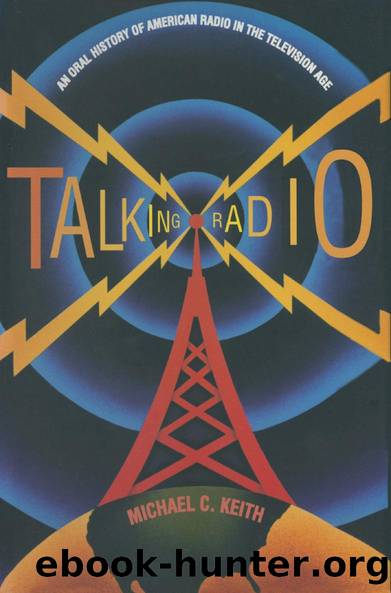Talking Radio: An Oral History of American Radio in the Television Age by Michael C. Keith

Author:Michael C. Keith [Keith, Michael C.]
Language: eng
Format: epub
Tags: Social Science, Media Studies
ISBN: 9781000161380
Google: JSfxDwAAQBAJ
Publisher: Routledge
Published: 2020-07-24T03:51:14+00:00
Sign-off:
Itâs time to blow out the candle.
âJoel Cash
15
Equality for Some
A White Manâs Medium
All animals are created equal but some animals are more equal than others.
âGeorge Orwell
Although we live in the worldâs greatest democracy, with arguably the most democratic system of broadcasting, radio has not always been what might be described as an equal-opportunity employer. In fact, until the last quarter of the twentieth century, women and minorities were difficult to locate on the radio dial, not to mention in off-air positions. American radio was nearly the exclusive domain of white males until the 1970s, yet women and minority participation in radio has existed since the mediumâs beginning.
During the years leading up to World War II, women, African Americans, and Hispanics found occasional work as performers, with the first group finding steadier employment (most typicallyâbut not always) in clerical positions. Nineteen forty-eight was a benchmark year in the history of ânonwhite maleâ broadcasting, because it witnessed the appointment of Frieda Hennock to the FCC as one of its seven commissioners and the debut of the first full-time black and Hispanic stationsâlocated in Tennessee and Texas, respectively. Today, there are thousands of ethnic (Hispanic claims the largest audience) and black stations around the country, and the number of women and minorities on the air and in staff and managerial positions in mainstream radio has increased manifold times, although it is still considerably below the figure for white males in the industry.
Meanwhile, the New York Times recently reported that âthe number of minority-owned FM stations has dropped significantly in the last four years.â1 Given the continued consolidations and mergers in the radio industry, it is foreseeable that even fewer minorities will be in on station ownership in the next few years.
However, in 1999, a ray of hope existed that this might change as the result of a possible FCC action that would see the authorization of a category of low-power FM frequencies aimed at making station licenses more available to groups that have traditionally been blocked from broadcast participation.
Paul Hedberg: Itâs curious to note that recent figures revealed that minority ownership of broadcast stations in America is about two percent. Twenty years ago it was at about that figure, too. Not much progress in that area.
Cecil Hale: Before the nineteen-forties, black radio existed only in the form of âstripsâ (blocks or segments) at a handful of stations around the country. During the early days of radio (late nineteen-twen-ties), black participation in radio was very minor. There were few performers (none solo) and no managers. There were no African American network solo stars. The closest that national radio of this period ever came to a black programming presence was as a caricature of American black life. Gosden and Correllâs Amos η â Andy, a comedy program featuring white performers interpreting a black dialect, became the national entertainment descriptor of black life in the country. This program was wildly popular. However, it was seen by African Americans as demeaning and promoting stereotypical perceptions of black America.
Download
This site does not store any files on its server. We only index and link to content provided by other sites. Please contact the content providers to delete copyright contents if any and email us, we'll remove relevant links or contents immediately.
Still Foolin’ ’Em by Billy Crystal(36204)
Spell It Out by David Crystal(35992)
The Great Music City by Andrea Baker(31087)
Professional Troublemaker by Luvvie Ajayi Jones(29539)
Trainspotting by Irvine Welsh(21448)
Call Me by Your Name by André Aciman(20314)
We're Going to Need More Wine by Gabrielle Union(18906)
The Secret History by Donna Tartt(18752)
Cat's cradle by Kurt Vonnegut(15101)
Ready Player One by Cline Ernest(14440)
Molly's Game by Molly Bloom(14023)
Bombshells: Glamour Girls of a Lifetime by Sullivan Steve(13928)
The Goal (Off-Campus #4) by Elle Kennedy(13369)
Leonardo da Vinci by Walter Isaacson(13107)
4 3 2 1: A Novel by Paul Auster(12222)
The Social Justice Warrior Handbook by Lisa De Pasquale(12082)
The Break by Marian Keyes(9264)
Crazy Rich Asians by Kevin Kwan(9125)
Adultolescence by Gabbie Hanna(8783)
